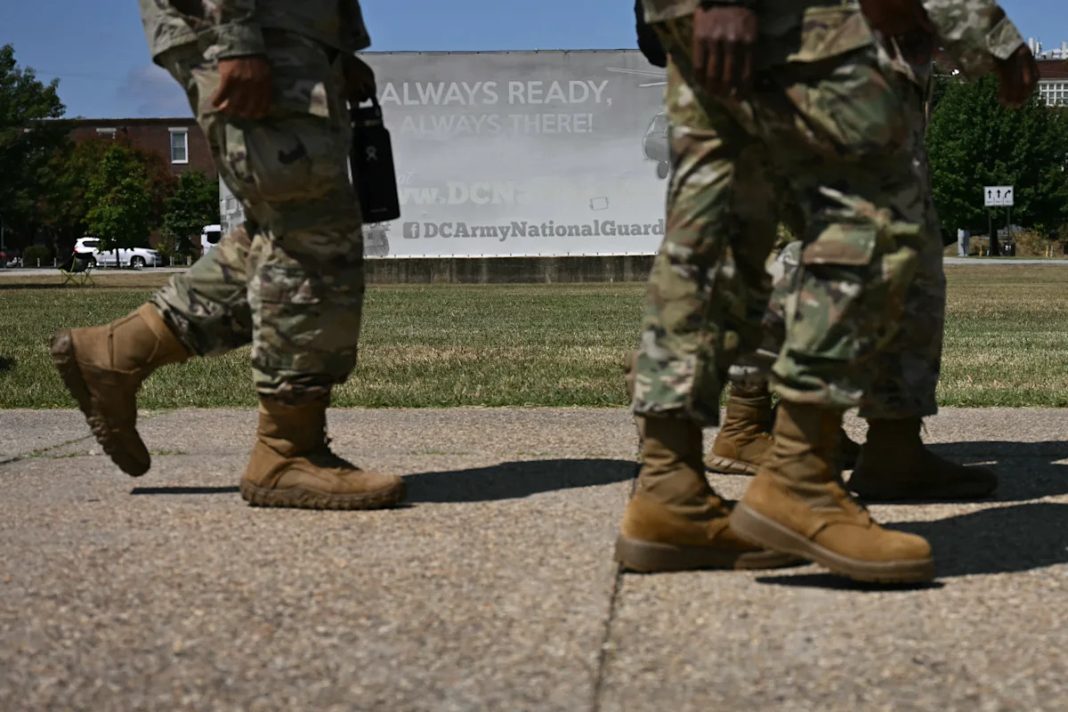When President Trump announced his plan Monday to send 800 National Guard troops to Washington, D.C., to crack down on what he described as “crime, bloodshed, bedlam and squalor” in the nation’s capital, he also issued a warning to other cities around the country.
“We’re going to take back our capital,” Trump said. “And then we’ll look at other cities also.”
But can Trump actually send federal forces elsewhere? And what cities might he target? Here’s everything you need to know about the president’s warning.
What did Trump say about sending the National Guard into other cities?
During his news conference on Monday, Trump singled out Chicago, Los Angeles, New York, Baltimore and Oakland, Calif. as “other cities also that are bad, very bad.”
“They’re so far gone,” he continued. “We’re not going to let it happen. We’re not going to lose our cities over this. And this will go further. We’re starting very strongly with D.C. and we’re going to clean it up real quick, very quickly, as they say.”
Beyond that, the president didn’t elaborate on his plans. But he did issue what amounted to an ultimatum: “self-clean up” or else.
“Other cities are hopefully watching this,” Trump said. “Maybe they’ll self-clean up, and maybe they’ll self-do this.”
But “if they don’t learn their lesson, if they haven’t studied us properly,” he continued, “then I’m going to look at New York in a little while. … And if we need to, we’re going to do the same thing in Chicago, which is a disaster.”
Later Monday, Trump issued an executive order directing Defense Secretary Pete Hegseth to coordinate with state governors and “authorize the orders of any additional members of the National Guard to active service, as he deems necessary and appropriate, to augment this mission.”
What does the law say about Trump’s plans?
Trump’s actions in Washington, D.C., are legal. As you may remember from elementary school, D.C. isn’t a state. It isn’t part of any other state either. It doesn’t have a constitution of its own. Instead, D.C. is what’s known as a “federal district,” and it’s been mostly under the jurisdiction of the U.S. Congress since its founding in 1791.
In 1973, Congress passed the Home Rule Act, which allowed D.C. residents to elect their own mayor and council members. But the law doesn’t give D.C. complete autonomy. Even now Congress controls its budget. Congress also has the power to review and block local legislation.
The president, meanwhile, still appoints D.C.’s judges — and he still leads its National Guard. He can also take control of the District’s police force by invoking Section 740 of the Home Rule Act, which is precisely what he did Monday.
But Trump doesn’t have the same powers across the rest of the country. Under current law, governors are in charge of each state’s National Guard and the police are largely controlled locally.
Trump has already challenged some of these rules. Over the objections of state and local officials, he deployed nearly 5,000 National Guard members and U.S. Marines to Los Angeles in June after a new round of ICE workplace raids sparked protests marred by sporadic violence.
California Gov. Gavin Newsom swiftly sued the administration to end the mobilization, claiming that Trump was violating the Posse Comitatus Act of 1878, which prohibits the president from deploying the armed forces to participate in domestic law enforcement operations unless he declares that an insurrection is underway.
A federal judge agreed with Newsom, but an appeals court blocked that ruling. Now Trump and Newsom are facing off in a three-day trial that began on Monday in San Francisco to determine whether Trump has the authority to do what he did in L.A. in other cities such as Chicago and New York.
A verdict is expected Wednesday.
What does Trump hope to accomplish by mentioning other cities?
Whether the president sends federal forces into other cities remains to be seen; much depends on the outcome of the current trial in California (and any subsequent appeals).
In the meantime, Trump was clear on Monday: He wants to pressure Democratic-run cities to change certain policies he disagrees with.
One policy he mentioned was cashless bail, which eliminates the requirement for defendants to pay money to be released from jail before their trial. Supporters say the policy addresses disparities in the justice system, where those who can afford bail are released while those who cannot remain incarcerated; critics (like Trump) say that it puts the public at risk by releasing potentially dangerous individuals back into the community.
Maybe other cities will “get rid of the cashless bail thing and all of the things that caused the problem,” Trump said Monday. “I mean, if you go back, this whole thing with cashless bail is a disaster. So many problems came that we never had before.”
Have local officials pushed back?
Yes. As Yahoo News reported Monday, “the president’s description of crime in Washington, D.C., is not reflected in official statistics, which show that the city had its lowest violent crime rate in over 30 years in 2024. The rates of homicide, sexual abuse, assault with a dangerous weapon and robbery all fell by at least 25% compared to 2023, according to statistics from the U.S. attorney’s office for the district.”
On Sunday, D.C. Mayor Muriel Bowser, a Democrat, cited similar statistics to claim that Trump is prioritizing politics over policy.
“If the priority is to show force in an American city, we know he can do that here,” Bowser told MSNBC. “But it won’t be because there’s a spike in crime.”
Officials elsewhere have repeated that message. On Monday, the U.S. Conference of Mayors responded to Trump’s actions and statements by touting a “nationwide success story” of plummeting crime rates. An FBI report released Aug. 5 found that between 2023 and 2024, violent crime nationwide dropped by 4.5%, with murder and non-negligent manslaughter falling by nearly 15%.
“Ultimately, the best public safety outcomes are delivered by local police departments and local officials, who know the communities,” Oklahoma City Mayor David Holt, president of the mayors’ conference, said in a statement. “America’s mayors never see takeovers by other levels of government as a tactic that has any track record of producing results.”

